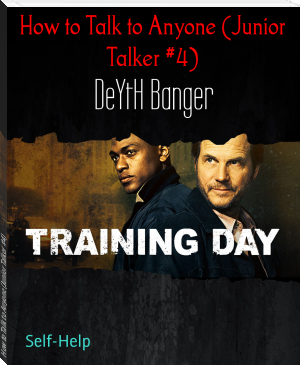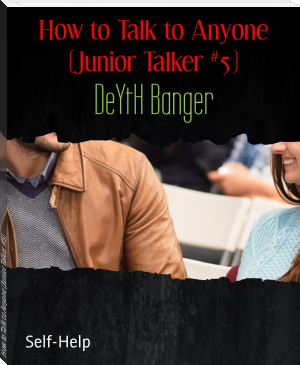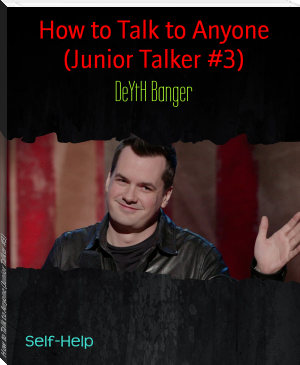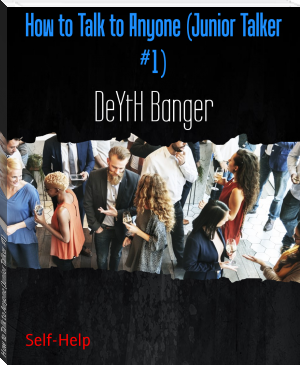How to Talk to Anyone (Junior Talker #4) by DeYtH Banger (novels in english TXT) 📕

- Author: DeYtH Banger
Book online «How to Talk to Anyone (Junior Talker #4) by DeYtH Banger (novels in english TXT) 📕». Author DeYtH Banger
by DeYtH Banger
Open1) I just started watching stand up comedians... you see them on stage and they say all type of shit and they never give a fuck.
2) Michael from Vsauce is really fucked up guy... not from a bad aspect... but from a good one... he say all type of shit and he makes it a big deal... how much cool is that?
You read books and you read all type of shit and you never give it a chance to go and start blooming and gloosiming out of content. You live in depression!?
(If You want better life... come and join us here...)
Quotes “Talk, talk, talk: the utter and heartbreaking stupidity of words.”
― William Faulkner, Mosquitoes
“I wanted to talk to someone. But who? It’s moments like this, when you need someone the most, that your world seems smallest.”
― David Levithan, Dash & Lily's Book of Dares
“Almost nothing need be said when you have eyes.”
― Tarjei Vesaas, The Boat in the Evening
“There is no greater plague to an introvert than the extroverted.”
― Pierce Brown, Golden Son
“Nothing is as irritating to a shy man as a confident girl.”
― Mokokoma Mokhonoana
“An extrovert looks at a stack of books and sees a stack of papers, while an introvert looks at the same stack and sees a soothing source of escape.”
― Eric Samuel Timm
Content Open Quotes
Part 1
Chapter 1 - Rejection Chapter 1.1 - Rejection (Part 2) Chapter 2 - Rejection (Part 3) Chapter 3 - Books Chapter 4 - Secrets Chapter 5 - Insights (Part 1) (Porn) Chapter 5.1 - Insights (Part 2) (Porn) Chapter 5.2 - Insights (Part 3) (Porn) Chapter 6 - LeT's TaLk Chapter 7 - Need (Part 1) Chapter 8 - More Chapter 8.1. - More (Part 2) Chapter 9 - Women Chapter 9.1. - Women Chapter 9.2. - Women Chapter 10 - Tips Chapter 10.1. - It's Not Rejection Chapter 10.2. - Spot LIGHT Chapter 11 - Roger Chapter 12 - My Style (Aka Provacative) Chapter 13 - Extra Material Chapter 14 - Secrets (MAGIC) Chapter 15 - Secret (Magic) (Part 2) Chapter 16 - Rape Method (Part 1) Chapter 17 - Rape Method (Part 2) Chapter 18 - Rape Method (Part 3)
Part 2
Chapter 1 - Those Days Chapter 2 - Bright Light
Part 3
Chapter 1 - N o N e e D F o r M o r E (Part 1) Chapter 1.1. - N o N e e D F o r M o r E (Part 2) Chapter 1.2. - N o N e e D F o r M o r E (Part 3) Chapter 2 - OFFENDED Chapter 3 - BE OFFENDED Chapter 4 - Secrets Chapter 5 - Secrets (Part 2) Chapter 6 - Secrets (Part 3) Chapter 7 - Secrets (Part 4) Chapter 8 - Bill Maher (WORLD OF JOKES) (Part 1) Chapter 8.1 - Bill Maher (WORLD OF JOKES) (Part 2) Chapter 9 - ReVeAL (George Carlin Style) Chapter 10 - Talk Chapter 11 - Forward Chapter 12 - God (Truth) Chapter 13 - Suppress Sexual Thoughts
Part 1
1. How is a woman like a condom?
Both spend more time in your wallet than on your dick.
2. What was David Bowie’s last hit?
Probably heroin.
3. What’s the difference between a joke and two dicks?
You can’t take a joke.
4. What do you call a deaf gynecologist?
A lip reader.
5. I hope Death is a woman.
That way it will never come for me.
6. What did the elephant say to the naked man?
How do you breathe through that tiny thing?
7. Why do women always have sex with the lights off?
Because they never like to see a man having a good time.
8. What do you call a cheap circumcision?
A rip off.
9. What does a woman’s pussy and a chainsaw have in common?
Miss by few inches and you’re in deep shit.
10. Did you hear about the blind prostitute?
Well, you got to hand it to her.
11. Men vacuum in the same way that they have sex.
They just put it in and make some noise for 3 minutes before they collapse on the couch and think that their wife should be really happy.
12. A daughter asked her mother, “Mom, how do you spell ‘scrotum’?”
Her mom replied, “Honey, you should have asked me last night—it was on the tip of my tongue.”
Chapter 1 - RejectionBeen Rejected? You May Be a Better Judge of Genuineness
Who knew that rejection might have an upside? After being dumped by a boyfriend or girlfriend, the only things we feel good at is, well, being rejected.
But in a strange twist of evolutionary fate, apparently that rejection may sensitize us to genuineness in others and being better able to spot fake or artificial emotions. The researchers tested their hypothesis on undergraduates and smiles:
The research found that subjects who were manipulated to feel rejection were able to distinguish a fake smile from a real one nearly 80 percent of the time. Researchers studied 32 subjects, 17 women and 15 men. […]
“Some thought the subjects who had been rejected would latch on to any sign of positivity and accept the insincere smiles as genuine,” Bernstein said. “But it’s clear we’re equipped with radar for identifying who is open to affiliation and who is not.”
It may not work with other displays of emotion, however. For instance, can we tell if someone is being genuine if they say, “Oh, I’m so sorry to hear you two broke up”? After all, that would seem to be something of more use to a person who just faced rejection, rather than a smile.
It’s a very small study, done with undergraduates, who were manipulated into feeling something (versus a feeling resulting from a genuine life situation), so the results must be taken with a grain of salt. Still, it’s an intriguing discovery and it’ll be interesting to see if future research confirms this finding.
Deconstructing the Fear of Rejection: What Are We Really Afraid Of?
The fear of rejection is one of our deepest human fears. Biologically wired with a longing to belong, we fear being seen in a critical way. We’re anxious about the prospect of being cut off, demeaned, or isolated. We fear being alone. We dread change.
The depth and flavor of fear varies for each individual, although there are common elements at play. If we’re willing to look, what is our actual felt experience of rejection? What are we really afraid of?
On a cognitive level, we may be afraid that rejection confirms our worst fear — perhaps that we’re unlovable, or that we’re destined to be alone, or that we have little worth or value. When these fear-based thoughts keep spinning in our mind, we may become agitated, anxious, or depressed. Cognitively-based therapies can help us identify our catastrophic thoughts, question them, and replace them with more healthy, realistic thinking. For example, if a relationship fails, this doesn’t mean that we are a failure.
From an experiential or existential viewpoint (such as Eugene Gendlin’s Focusing), working with our fear of rejection or actual rejection involves opening to our felt experience. If we can have a more friendly, accepting relationship with the feelings that arise within us as a result of being rejected, then we can heal more readily and move on with our lives.
A big part of our fear of rejection may be our fear of experiencing hurt and pain. Our aversion to unpleasant experiences prompts behaviors that don’t serve us. We withdraw from people rather than risk reaching out. We hold back from expressing our authentic feelings. We abandon others before they have a chance to reject us.
Being human, we long to be accepted and wanted. It hurts to be rejected and to experience loss. If our worst fear materializes — if our catastrophic fantasy becomes a reality and we’re rejected — our organism has a way of healing if we can trust our natural healing process. It’s called grieving. Life has a way of humbling us and reminding us that we’re part of the human condition.
If we can notice our self-criticisms and tendency to sink into the shame of being a failure and accept our pain just as it is, we move toward healing. Our suffering is intensified when not only do we feel hurt, but we think something’s wrong with us for feeling it.
If we risk opening our heart to someone who rejects us, it doesn’t have to be the end of the world. We can allow ourselves to feel





Comments (0)